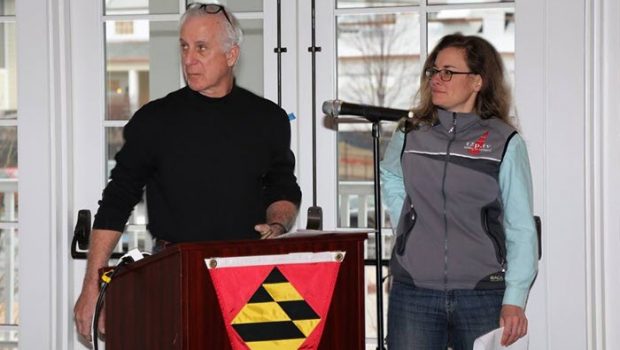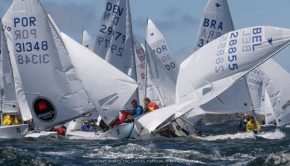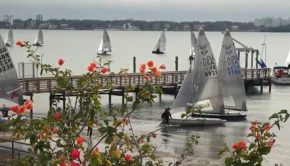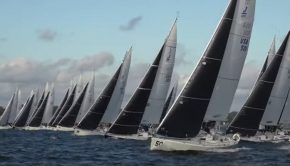Connecting with an Audience
Published on March 12th, 2019
When Annapolis Yacht Club held its inaugural Race Officials Symposium in February 2019, among the expert presentations came from Bruce Nairn and Ashley Love of T2PTV. As the leaders of a full service video production, broadcast, sales, and marketing company, they discussed how regatta officials and event organizers can best reach their audience at their regattas.
Here is Ashley’s summary of their presentation:
Bruce Nairn, the President of Operations of T2PTV and one of the co-founders with Tucker Thompson back in 2000, kicked off the presentation with some personal stories about what his lifetime of competitive sailing has meant to him and how grateful he is to regatta officials and race committee members. Without their altruism and tremendous effort, the sport would simply not exist.
Nairn and Thompson began T2PTV not just as a sailing media production company, but also as a sponsor fulfillment asset for regattas. Our clients are the regatta organizers, but their clients are the participants, interested parties, and the sponsors whose involvement keeps the lights on.
Regattas grow if sponsors are kept happy, if participants share their experience through the content provided by the regatta, and if a broader audience is attracted to the club, the association, the sailing center, the town, the class of boats, the sport, etc.
How can content be leveraged to make sure the goal is reached? Social media is an obvious go-to and is a realm of communication that has entire seminars dedicated to just that topic.
In our allotted fifty minutes, the plan was to teach some basic social media vocabulary and point out the significant differences between the two biggest social media platforms out there today: Facebook and YouTube. We hoped to open people’s eyes to the “social media construct” so they couldn’t have the wool pulled over their eyes by its inherently slippery metrics.
Vocabulary for social media starts with the words like “view”, “average length of view”, and “reach”. The important point here is that Facebook and YouTube define these definitions very differently, so when and if you are trying to compare the two sets of analytics, always make sure you are comparing apples to apples.
This is where Nairn handed the microphone over to me. I’m the Editor in Chief of T2PTV and have been working for the company for 10 years now. I grew up sailing and I consider myself extremely lucky to be able to combine my passion for the sport with my love for storytelling into an occupation.
 As a team, Nairn and I have created thousands of shows in and outside of the sailing world for clients all over the world and had our work featured on network television, in film festivals and all over the Internet.
As a team, Nairn and I have created thousands of shows in and outside of the sailing world for clients all over the world and had our work featured on network television, in film festivals and all over the Internet.
Social media had its boom well after T2PTV was fulfilling sponsor needs by putting video online, so we have been meticulous in our research on the subject. Regatta officials should be aware of what social media analytics ought to be used for. The number of “views”, the number of “shares” are not the goal.
In the planning process of every regatta, a list of goals should be compiled. Ask yourselves, what is the point? This helps determine who their audience is and what their message is.
Examples of goals could be helping junior sailors transition into adult sailing, getting more people to join the club, raising awareness for what a charity regatta is fundraising for, and/or bringing in more sponsors. The goal and the message are worked into the media (video/photo/written word) coverage from the start and the analytics you gather, from social media and offline, are merely a tool to measure if that goal was reached.
Social media analytics like your “reach” and your “engagement (likes/comments)” combined with your offline analytics like the number of registrations, sponsor dollar amounts, the number of international or youth participants bring you to the most important analytic: “conversion”.
How many people converted from a nonparticipant to a participant? How many junior sailors converted to adult sailors? How many companies and foundations converted to being sponsors? “Conversion” is the endgame.
When it comes to using social media affectively, remember to think like your audience. When your participants get off the water and want to see the day’s racing, it better be ready for them that same night or it’s old news. News is time-sensitive, so deliver. Where are eager viewers going to go look for content? If they can’t find it in the first few minutes of searching, they will give up, so make everything as intuitive as possible.
The first place people should go is the regatta’s home page. Video, photos, press releases, audio recordings of interviews, results, the NOR, the SIs and other announcements should be easy to locate on your regatta’s home page. An added benefit is that they will see the sponsors’ logos and your yacht club/association/sailing center’s branding again and again.
The regatta website can also easily bring your audience to your Twitter feed, your Facebook page, your YouTube channel, and/or your Instagram account so they can see not only see related content, but participate in your outreach.
Everyone has a phone and therefore a camera. Make it easy for them to share your official video and regatta photos on their profile pages AND to post their own content of them getting their sail repaired by the title sponsor, eating out at a local restaurant, or ogling over a dolphin that swam with them on the way home to the dock.
When they post something, they will mention your regatta in the description if it is easy, so make all of your event’s account names, handles and hash tags the same and easy to find. Consider putting a card in the skipper bags or a message up on the event website.
“ROLEX Big Boat Series” #rolexbigboatseries @rolexbigboatseries
In summary, when you are starting to organize an event, discuss and choose your goal and decide what advertising budget and media team will get you there so you know what kind of sponsorship dollars you will need. The sponsors will be easier to attain if you are helping them with their mission.
A strong media team helps your sponsor just as much as it helps the host organization. The analytics you gather from your outreach, before, during and after the event, will help you figure if you reached that goal and help you adapt and grow into the next biggest regatta in the United States.
We are all already so lucky that sailing is our passion. The beauty of sailing, the majesty, the way it can alter the course of someone’s life, let them escape from life on land, is art in the making.
Sailing creates communities, teaches life skills and presents challenges that when captured correctly can inspire others and draw them in. So keep the conversation going. Always dig further and ask the tough questions. Your event will be better for it and so will the sport of sailing.
For a full report on the Race Officials Symposium… click here.









 We’ll keep your information safe.
We’ll keep your information safe.